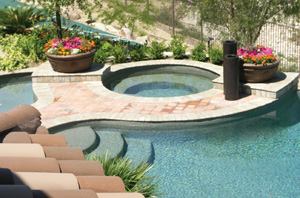Traditional pebble finishes. Pools with this finish have a bumpier feeling, because pebbles are exposed and raised. To get this texture, crews apply a combination of pebbles and plaster, achieving the right compaction of stone. They then rinse off the top layer of plaster, bringing the stones into relief. Experienced applicators know how to rinse off exactly the right amount of plaster to expose the pebbles, without making them vulnerable to falling out of the mix.
The aggregates come in a variety of sizes, so the finish can be pebblier or have a finer, granite-like appearance. Some contain seashells for sparkle. The added texture gives it a unique look, but some people don’t like the feeling. Because of its nature, however, seashell will not be guaranteed against degradation.
These pebble finishes are a favorite of many surface specialists. “I like the bullet-proof nature of pebble,” Kostka says. “It has a lot less problems with etching and discoloration than the other surfaces.”
Polished aggregate finishes. This is regular exposed aggregate—minus the bumpiness—and feels the most like glass tile. “Polished finishes would appeal more to people who are texture-conscious about the bottom of their pool,” says Kirk Chapman, president of Gemstone Pool Surfaces Inc. in Lakeside, Calif.
Applicators trowel the material on then, after a light acid wash, go over the entire surface with diamond disc pads. “You’re trying to take off 1/1000 of an inch of [plaster] to expose the aggregate,” says David Cooke, president of David Cooke Plaster Co. LLC in South Windsor, Conn. When it’s finished, you can still see the aggregate and a small amount of plaster, but everything’s been ground flat.
Once it’s underwater, polished aggregate is nearly indistinguishable from pebble finishes. Both leave a rich, almost sandy look to the bottom of the pool, making them especially suitable for more naturalistic designs.
As far as application is concerned, the secret is in the troweling and polishing. Crews must first lay down a very consistent thickness of material around the pool. This will ensure uniform exposure as they grind down the top layer. During polishing, crews should begin with a coarse grit diamond disc and work down to finer grits to get the right smoothness. Constantly wet the pads or power the discs with a pressure washer to remove the resulting dust and prevent swirl marks from forming. “By using water as your power source, it washes it as you go,” Cooke says.
Quartz aggregates. These look most like plaster, and the application is similar as well. The aggregates are very fine, comparable to the sand you’d use in a regular plaster mix. For a monochromatic, plaster-like look, applicators match the plaster with the aggregate. To get more of a granite-like appearance, they’ll mix it up.
Many believe the quartz aggregate holds up longer than the marble used on regular plaster. It’s also a little trickier to apply, so crews must have patience. “Once a quartz product starts to dry, it becomes very hard,” Cooke says. So use about half the accelerator you normally would (or, better yet, avoid it altogether) so you’ll have more time to work the material properly.



